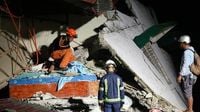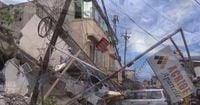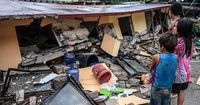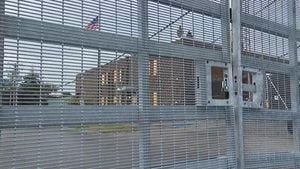Rescue teams in the Philippines are racing against time after a devastating magnitude 6.9 earthquake struck the central region late Tuesday night, killing at least 72 people and injuring more than 200, according to multiple reports from The Associated Press, ABC News, and The New York Times. The disaster has left dozens still missing, with the death toll expected to rise as desperate searches continue amid hazardous conditions and widespread destruction.
The powerful quake hit at about 10 p.m. local time on October 1, 2025, its epicenter located roughly 19 kilometers (12 miles) northeast of Bogo, a coastal city in Cebu province with a population of about 90,000. The Philippine Institute of Volcanology and Seismology reported that the earthquake struck at a dangerously shallow depth of just 5 kilometers (3 miles), amplifying the destructive force felt on the surface. The event was among the most severe to hit the region in over a decade, and its impact was immediate and catastrophic.
Rescue operations began in earnest as soon as it was safe to do so, with teams using backhoes, sniffer dogs, and even their bare hands to sift through the rubble of collapsed houses, businesses, and public buildings. In Bogo city, rescuers in orange and yellow hard hats worked through the night under spotlights, searching for signs of life among the debris. Yet, as of Wednesday night, no additional survivors had been found in some of the worst-hit structures.
"We’re still in the golden hour of our search and rescue," said Office of Civil Defense deputy administrator Bernardo Rafaelito Alejandro IV during a Wednesday morning briefing in Manila. "There are still many reports of people who were pinned or hit by debris." The urgency was palpable, as officials warned that the chances of survival diminish with every passing hour.
The devastation was not limited to Bogo. Outlying towns such as Medellin and San Remigio also reported fatalities, including three coast guard personnel, a firefighter, and a child who were killed by collapsing walls and falling debris while trying to flee a sports complex during the quake, as town officials told The Associated Press. Landslides triggered by the tremor, especially in the mountainous village of Tabuelan, further complicated rescue efforts. In these remote areas, workers struggled to transport heavy machinery through hazardous terrain, with rain-soaked mountainsides raising the risk of additional slides.
The immediate aftermath was chaotic and traumatic for survivors. Thousands of residents, fearing aftershocks and further collapses, refused to return to their homes. Instead, they spent the night in open fields and parks, braving intermittent rain. The trauma was compounded by the fact that just days earlier, a tropical storm had battered the same region, killing at least 27 people, causing widespread power outages, and forcing mass evacuations.
"This was really traumatic to people. They’ve been lashed by a storm then jolted by an earthquake," said Teresito Bacolcol, director of the Philippine Institute of Volcanology and Seismology, according to The Associated Press. He added, "I don’t want to experience what they’ve gone through." The institute also noted that more than 600 aftershocks had been detected since the main quake, with experts warning that such tremors could continue for months, though they are expected to decrease in frequency and intensity over time.
The earthquake caused widespread destruction across central Cebu and neighboring provinces. In addition to collapsed homes, the quake rendered at least two or three hospitals unusable, damaged churches, government buildings, and businesses, and left multiple bridges and roads impassable. Two seaports, in San Remigio and Bogo, were reported non-operational, hampering both rescue logistics and the delivery of aid. As of Wednesday morning, eight cities and municipalities were without power, while three had lost all communication capabilities, as reported by The Washington Post.
The disruption extended to daily life, with classes suspended in 46 schools and work halted in multiple cities and towns while the safety of buildings was assessed. Cebu Governor Pamela Baricuatro responded by placing the entire province under a state of emergency, a move echoed by local officials throughout the region. Public works personnel were dispatched to inspect infrastructure and coordinate ongoing recovery efforts.
In the face of such overwhelming need, the Philippine government began considering whether to seek help from foreign governments, pending the results of rapid damage assessments. Offers of support quickly arrived from around the world. "We stand ready to support the Philippine government’s response as friends, partners, allies," said MaryKay Carlson, the U.S. ambassador to the Philippines, in a statement on X. Condolences and pledges of assistance also came from Japan, Australia, and the European Union.
Authorities briefly issued a tsunami warning for the coastlines of Cebu and nearby provinces Leyte and Biliran, but the alert was lifted within hours after no significant waves were detected. Nonetheless, the initial warning contributed to the anxiety and confusion among residents already reeling from the quake and previous storm.
Experts believe the earthquake likely originated along an unmapped fault in the Earth’s crust—a not uncommon occurrence in the Philippines, given its location on the Pacific "Ring of Fire." This region is notorious for frequent seismic activity, including earthquakes and volcanic eruptions. In fact, a similarly strong quake in 2013, also along an unmapped fault, claimed more than 200 lives. The archipelago’s vulnerability is heightened by the fact that many faults remain unidentified, often running beneath densely populated areas and even beneath the sea.
In Indonesia, the same day, disaster struck as dozens of students went missing after their school collapsed during a prayer service, underscoring the seismic volatility of the region. While the two disasters were not directly linked, they served as a stark reminder of the risks faced by communities across Southeast Asia.
As the search for survivors continues, the focus remains on saving lives and providing relief to those affected. The coming days will be critical, as emergency teams work to clear debris, restore essential services, and offer comfort to the thousands left homeless and traumatized. The resilience of the Filipino people is being tested yet again, but with international support and determined local leadership, there is hope that recovery will follow even this darkest hour.






